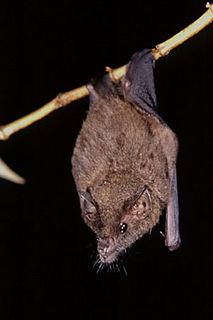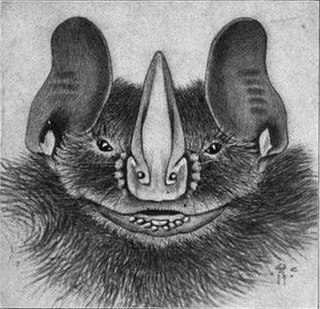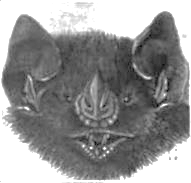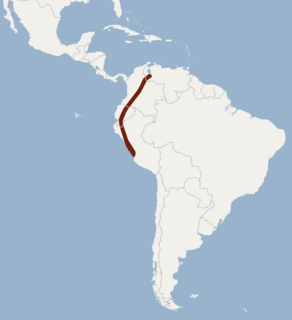
The big-eared woolly bat or (Peters's) woolly false vampire bat is a species of bat, belonging to the Order Chiroptera and Family Phyllostomidae.

Geoffroy's tailless bat is a species of phyllostomid bat from the American tropics.

The silver fruit-eating bat is a South American bat species of the family Phyllostomidae.

The gnome fruit-eating bat is a bat species from South America. It is found in Bolivia, Brazil, Colombia, Ecuador, French Guiana, Guyana, Peru, Suriname and Venezuela. This species was originally discovered to be different from the other known species of fruit bats, but later, in 1994 were mistakenly grouped under Artibeus cinereus as a synonym. However, this has since been corrected by more closely studying their physical differences and by biomolecular analysis.

Dekeyser's nectar bat is a bat species from South America. It is found in Brazil and Bolivia.

The white-throated round-eared bat is a South and Central American bat species found from Honduras to Bolivia, Paraguay and Brazil. It creates roosts inside the nests of the termite, Nasutitermes corniger. It thrives on a mainly insect-based diet, focusing on the surfaces of foliage to hunt, and also eats fruit and pollen. It has a very wide range and is a common species over much of that range, so the International Union for Conservation of Nature has assessed its conservation status as being of "least concern".

The great stripe-faced bat or stripe-faced vampire bat is a bat species from South and Central America, where it is found from southern Mexico to Bolivia and northwestern Brazil, as well as on Trinidad. The great stripe-faced bat is a frugivore. It is one of two species within the genus Vampyrodes the other being Vampyrodes major.

Dermanura is a genus of leaf-nosed bats.

The flat-faced fruit-eating bat is a South American species of bat in the family Phyllostomidae. It is sometimes considered a subspecies of the Jamaican fruit bat, but can be distinguished by its larger size, the presence of faint stripes on the face, and of a third molar tooth on each side of the upper jaw. Genetic analysis has also shown that the two species may not be closely related.

The Bogotá yellow-shouldered bat is a species of bat in the family Phyllostomidae. It is found in Colombia, Ecuador, Peru, and Venezuela at altitudes from 300 m to above 2000 m, particularly in cloud forest. The species is primarily frugivorous; it may also consume nectar and pollen.
Desmodus draculae is an extinct species of vampire bat that inhabited Central and South America during the Pleistocene, and possibly the early Holocene. It was 30% larger than its living relative the common vampire bat. Fossils and unmineralized subfossils have been found in Argentina, Mexico, Ecuador, Brazil, Venezuela, Belize, and Bolivia.

Thomas's fruit-eating bat, sometimes also popularly called Watson's fruit-eating bat, is a species of bat in the family Phyllostomidae. It is found from southern Mexico, through Central America to Colombia. Its South American range is to the west of the Andes. The species name is in honor of H. J. Watson, a plantation owner in western Panama who used to send specimens to the British Natural History Museum, where Oldfield Thomas would often describe them.
Rosenberg's fruit-eating bat is a species of bat in the family Phyllostomidae. It is found in humid tropical forests in the El Chocó region on the coast of western Colombia and northwestern Ecuador at altitudes below 500 m. Until recently it was included within D. glauca, a canopy frugivore that also eats insects. It was elevated to full species status in 2009. The specific name is in honor of collector W. F. H. Rosenberg. The species is regarded as common, but is likely threatened by the deforestation of its habitat.

Benkeith's short-tailed bat is a leaf-nosed bat species found in Peru, Bolivia, and Brazil. It very closely resembles the chestnut short-tailed bat, and the two species are likely often confused.

The western round-eared bat is a bat species found only on the Pacific coast of northwestern Ecuador.
The slender broad-nosed bat is a species of bat in the family Phyllostomidae. As a phyllostomid bat, it is characterized by a narrow uropatagium which is fringed with hair; a white dorsal stripe; large inner upper incisors convergent at the tips; and three upper and three lower molars. It is found in eastern Colombia and Ecuador, north-eastern Peru, and Venezuela. It is closely related to Platyrrhinus incarum and Platyrrhinus fusciventris.
The Bogota fruit-eating bat is a species of bat found in South America.
Dermanura rava is a species of leaf-nosed bat found in Central and South America.
Artibeus aequatorialis is a species of bat in the family Phyllostomidae. The bat is endemic to northwestern South America west of the Andes mountain range. It has been assessed as least concern by the IUCN.














